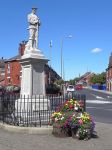Medlar-with-Wesham is a civil parish and an electoral ward on the Fylde in Lancashire, England, which contains the town of Wesham. It lies within the Borough of Fylde, and had a population of 3,245 in 1,294 households recorded in the 2001 census. rising to 3,584 at the 2011 Census.
History
The area within the boundaries of the parish have been populated since early medieval times, prior to the Norman conquest, with separate settlements at Bradkirk, Medlar, Wesham and Mowbreck. There was also a single moated farmstead at Pasture Barn midway between Medlar and Mowbreck. The present bridleway of Mowbreck Lane was the medieval route to Treales.
The modern town of Wesham is only about 160 years old, and developed as the railway expanded to serve the growing popularity of resort towns such as Blackpool. From the 1920s to the 1950s huge numbers of steam trains plied their way to the coast via the railway station at Kirkham and Wesham. Locals pronounce the name Wes-ham
Situated to the north of the railway station, from 1⁄2 to 2+1⁄2 miles (1 to 4 km) north of Kirkham, in 1870–72 it had an area of 1,971 acres (798 ha) and property worth £3,441. The population in 1851 was 170 but by 1861 was 563. The increase of population arose largely from additional employment in cotton mills. At that time the manor of Wesham, with Mowbreck Hall, belonged to J. T. Fazakerley-Westby. The hall was a fine edifice of red brick, castellated with stone and contained a domestic Roman Catholic chapel. It was once reputed to be haunted and had at one time been used as a Catholic school, one of whose pupils was Bible scholar George Leo Haydock.
A large school, used also as a lecture hall, belonging to the Independents, was built at Wesham in 1864 and opened in 1866. The premises is now the showroom for Salisburys Electricals.
A large new workhouse, to replace the much older one in Kirkham, was erected between 1903
